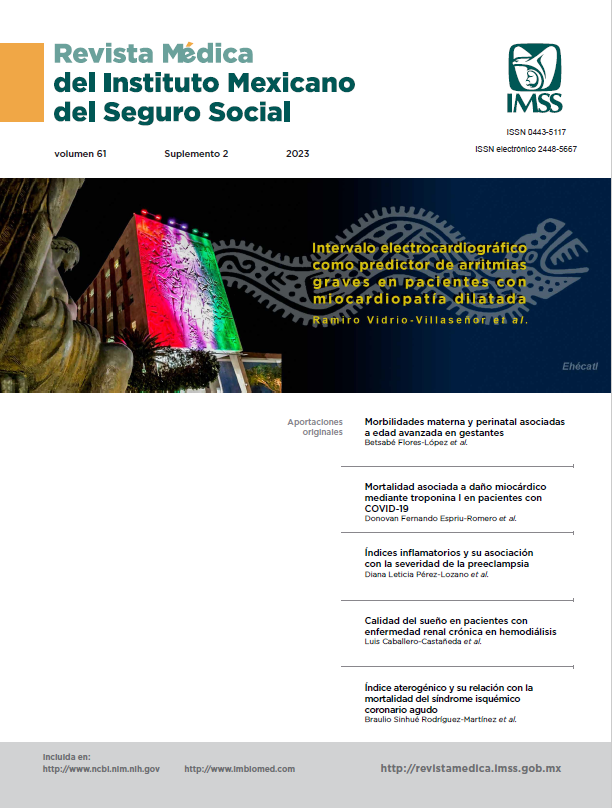Inflammatory indexes during remission induction of pediatric acute leukemia
Main Article Content
Keywords
Mortality, Pediatrics, Inflammation, Prognosis, Lymphoid, Leukemia
Abstract
Background: Inflammatory indexes can reflect the severity of serious diseases such as acute leukemia (AL), which is why they can predict mortality.
Objective: To evaluate the prognostic value of mortality of inflammatory indexes during the remission induction stage in patients with pediatric AL.
Material and methods: Observational, longitudinal, analytical and retrolective study. Patients aged 0 to 17 years, with a recent and confirmed diagnosis of AL, who had basal (at diagnosis, before the start of treatment) and final (at the end of remission induction, or, in the cases of death, during the period prior to this outcome) complete blood count were included.
Results: We included 78 patients, 67 with acute lymphoblastic leukemia (ALL), and 11 with acute myeloblastic leukemia (AML), with 11 and 2 deaths, respectively. Regarding ALL, no index showed significant cut-off points to distinguish deaths. Concerning AML, the indices whose cut-off points distinguished the patients who died in the basal measurement, were the monocyte-lymphocyte ratio (MLR) ≥ 3.11 (sensitivity [Se] 100%, specificity [Sp] 66.67%, AUC 0.8333, p 0.03), and, at the final measurement, the neutrophil-lymphocyte ratio (NLR) ≥ 1.30 and MLR ≥ 0.57 (both with Se 100% and Sp 88.89%, AUC 1.0, p < 0.00001) and systemic immune index (SII) ≥ 246612 (Se 100%, Sp 88.89%, AUC 0.9444, p < 0.0001). With bivariate analysis, only the latter demonstrated an increase in the risk of mortality (p = 0.02)
Conclusions: The basal MLR and the final NLR, MLR and SII are prognostic inflammatory indices of mortality in patients with AML undergoing remission induction.
References
Hunger S, Mullighan C. Acute Lymphoblastic Leukemia in Children. N Engl J Med. 2015;373(16):1541-52. doi: 10.1056/NEJMra1400972.
Instituto Nacional de Salud Pública. Leucemia infantil; México: INSP; 2021. Disponible en: https://insp.mx/assets/documents/webinars/2021/CISP_Leucemia.pdf.
Sekeres M, Gerds A. Mitigating Fear and Loathing in Managing Acute Myeloid Leukemia. Seminars in Hematology. 2015;52(3):249-55. doi: 10.1053/j.seminhematol.2015.03.009.
4.Smith M, Altekruse S, Adamson P, et al. Declining childhood and adolescent cancer mortality. Cancer. 2014;120(16):2497-506. doi: 10.1002/cncr.28748.
National Cancer Institute. Surveillance, Epidemiology, and End Results Program: Cancer Stat Facts: Leukemia — Acute Myeloid Leukemia (AML). Bethesda, Md: NCI, DCCPS, Surveillance Research Program; 2020. Disponible en: https://seer.cancer.gov/statfacts/html/leuks.html.
González-Salas WM, Olarte-Carrillo I, Gutiérrez-Romero M et al. Frecuencia de leucemias agudas en un hospital de referencia. Rev Med Inst Mex Seguro Soc. 2017;50(2):167-71. Disponible en: http://revistamedica.imss.gob.mx/editorial/index.php/revista_medica/article/view/1219/1865.
Aguilar-Hernández M, Fernández-Castillo G, Núñez-Villegas N et al. Principales causas de mortalidad durante la fase de inducción a la remisión en los pacientes pediátricos con leucemia linfoblástica aguda. Rev Med Inst Mex Seguro Soc. 2017;55(3):286-91. Disponible en: http://revistamedica.imss.gob.mx/editorial/index.php/revista_medica/article/view/313/2041.
Torres Courchoud I, Pérez Calvo JI. Biomarcadores y práctica clínica. Anales Sis San Navarra. 2016;39(1):5-8. Disponible en: https://scielo.isciii.es/scielo.php?script=sci_arttext&pid=S1137-66272016000100001&lng=es.
Che-Morales JL, Cortes-Telles A. Índice neutrófilo/linfocito como biomarcador sérico asociado con neumonía adquirida en comunidad. Rev Med Inst Mex Seguro Soc. 2018;56(6):537-43. Disponible en: http://revistamedica.imss.gob.mx/editorial/index.php/revista_medica/article/view/1711/3465.
Hwang S, Shin T, Jo I, et al. Neutrophil-to-lymphocyte ratio as a prognostic marker in critically-ill septic patients. Am J Emerg Med. 2017;35(2):234-239. doi: 10.1016/j.ajem.2016.10.055.
Martínez-Urbistondo D, Beltrán A, Beloqui O et al. El índice neutrófilo/linfocito como marcador de disfunción sistémica endotelial en sujetos asintomáticos. Nefrología. 2016;36(4):397-403. doi: 10.1016/j.nefro.2015.10.018.
Karagoz I, Yoldas H. Platelet to lymphocyte and neutrophil to lymphocyte ratios as strong predictors of mortality in intensive care population. Revista da Associação Médica Brasileira. 2019;65(5):633-6. doi: 10.1590/1806-9282.65.5.633.
Vasquez L, León E, Beltran B, et al. Pretreatment Neutrophil-to-Lymphocyte Ratio and Lymphocyte Recovery: Independent Prognostic Factors for Survival in Pediatric Sarcomas. J Pediatr Hematol Oncol. 2017;39(7):538-46. doi: 10.1097/MPH.0000000000000911.
Huang Z, Fu Z, Huang W, et al. Prognostic value of neutrophil-to-lymphocyte ratio in sepsis: A meta-analysis. Am J Emerg Med. 2020;38(3):641-7. doi: 10.1016/j.ajem.2019.10.023.
Seng D, Fang Q, Li P, et al. Prognostic Value of the Pretreatment Neutrophil-to-Lymphocyte Ratio in Pediatric Parotid Cancer. Frontiers in Pediatrics. 2019;7. doi: 10.3389/fped.2019.00207.
Lagunas-Alvarado M, Mijangos-Huesca FJ, Terán-González JO, et al. Systemic immune inflammatory index in sepsis. Med Int Mex. 2017;33(3):303-9. Disponible en: https://www.scielo.org.mx/pdf/mim/v33n3/0186-4866-mim-33-03-00303.pdf.
Basbus L, Lapidus MI, Martingano I et al. Índice neutrófilo-linfocito como factor pronóstico de COVID-19. Medicina (B. Aires). 2020; 80(Suppl 3):31-6. Disponible en: http://www.scielo.org.ar/scielo.php?script=sci_arttext&pid=S0025-76802020000500005&lng=es.
Beltran BE, Aguilar C, Quiñones P, et al. The neutrophil-to-lymphocyte ratio is an independent prognostic factor in patients with peripheral T-cell lymphoma, unspecified. Leuk Lymphoma. 2016;57(1):58-62. doi: 10.3109/10428194.2015.1045897.
Porrata L, Ristow K, Habermann T, et al. Predicting survival for diffuse large B-cell lymphoma patients using baseline neutrophil/lymphocyte ratio. Am J Hematol. 2010;85(11):896-9. doi: 10.1002/ajh.21849.
Stefaniuk P, Szymczyk A, Podhorecka M. The Neutrophil to Lymphocyte and Lymphocyte to Monocyte Ratios as New Prognostic Factors in Hematological Malignancies – A Narrative Review. Cancer Manag Res. 2020;12:2961-2977. doi: 10.2147/CMAR.S245928.
Ramos-Peñafiel C, Santos-González B, Flores-López E, et al. Usefulness of the neutrophil-to-lymphocyte, monocyte-to-lymphocyte and lymphocyte-to-platelet ratios for the prognosis of COVID-19-associated complications. Gac Med Mex. 2020;156(5):405-11. doi: 10.24875/GMM.M20000428.
Forget P, Khalifa C, Defour J, et al. What is the normal value of the neutrophil-to-lymphocyte ratio? BMC Research Notes. 2017;10(1). doi: 10.1186/s13104-016-2335-5.
Djordjevic D, Rondovic G, Surbatovic M, et al. Neutrophil-to-Lymphocyte Ratio, Monocyte-to-Lymphocyte Ratio, Platelet-to-Lymphocyte Ratio, and Mean Platelet Volume-to-Platelet Count Ratio as Biomarkers in Critically Ill and Injured Patients: Which Ratio to Choose to Predict Outcome and Nature of Bacteremia? Mediators Inflamm. 2018;2018:3758068. doi: 10.1155/2018/3758068.
Celik B, Nalcacioglu H, Ozcatal M, et al. Role of neutrophil-to-lymphocyte ratio and platelet-to-lymphocyte ratio in identifying complicated appendicitis in the pediatric emergency department. Ulus Travma Acil Cerrahi Derg. 2019;25(3):222-228. English. doi: 10.5505/tjtes.2018.06709.
Chen JH, Zhai ET, Yuan YJ, et al. Systemic immune-inflammation index for predicting prognosis of colorectal cancer. World J Gastroenterol. 2017;23(34):6261-72. doi: 10.3748/wjg.v23.i34.6261.


